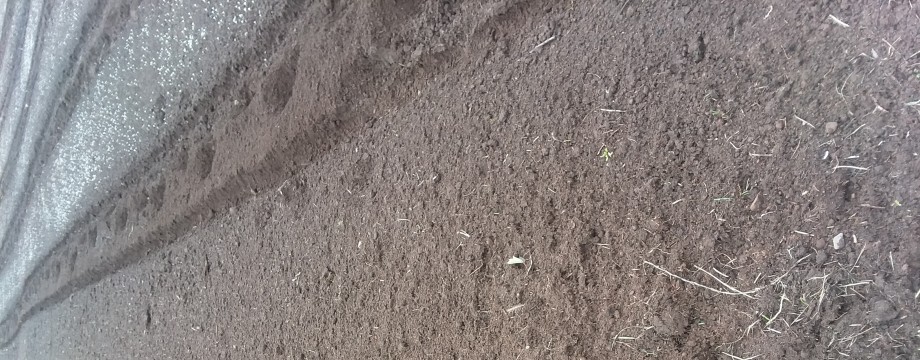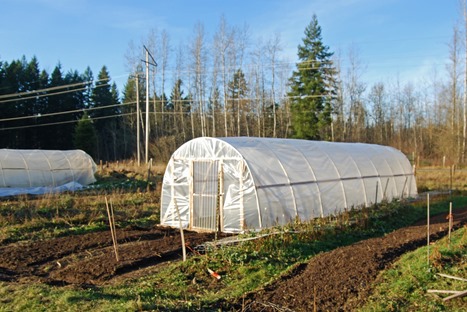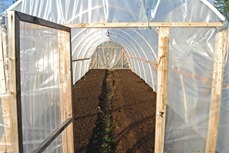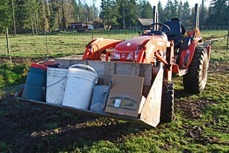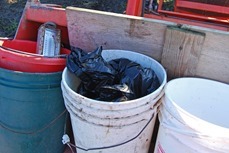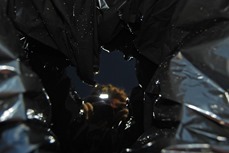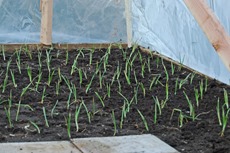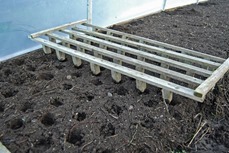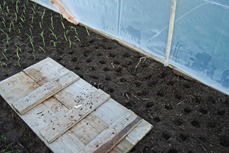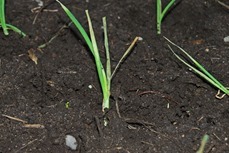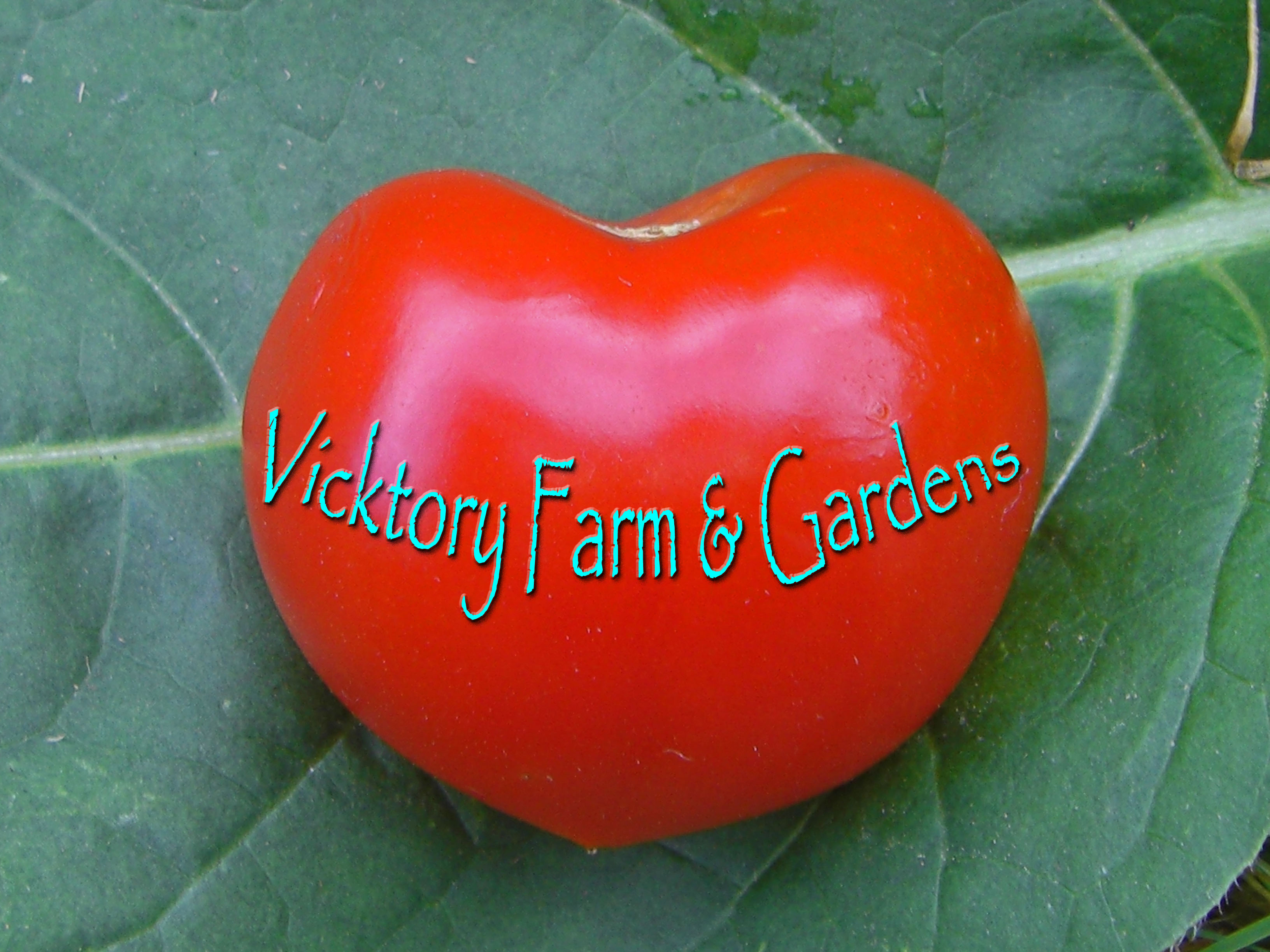Dirt, Bet and I finished up the onion hoop house on Sunday. I really did help, when they needed me, otherwise I was down in the carrot hoop house (I call it Carrot Barn) weeding and thinning baby carrots.
As soon as they were done, they headed off to kill roosters and turkeys and I stayed behind to begin planting the onions that had come from Dixondale last Friday.
When they arrived I took them out of the box. Actually I opened the box, took them out and looked at them, rearranged them in the box, left the top open and then made sure they were in a nice cool spot in the Market Shed. I figured that counted for “remove plants immediately!”
So when the onion hoop was done I went down to the “compound” and retrieved the box of onions and all the things I figured I needed: scale to weigh out the lime, some fish bone meal (all that I had left, which won’t be enough), the water can to deliver the liquid seaweed left over from soaking the planting garlic from last weekend, and the bucket of liquid seaweed.
Dear Reader, do you know how to haul a liquid so it doesn’t spill? Besides putting on the lid, I mean. Sometimes those lids can be a pain in the toosh, and sometimes you can’t find a lid. So do you know how not to have the liquid slosh out? Put a plastic bag in the bucket, put the liquid in, tie the bag and off you go, no spills, no slosh.
I also brought a knee board in the front loader with me. Dirt didn’t want to come back out and fasten the plastic film to the outside bottom edge, he fastened it before I planted, lazy bum. So I knew I would need a way to reach to the “back side” of the beds. Oh and I grabbed the “spacer” from the Tool Hoop where the bags of lime live.
The spacer is how I get the onion plants so nicely spaced. In the past we have abandoned the spacer for other methods. I wasn’t happy in the long run, so I’ve gone back to the spacer.
I move the spacer along the bed, press down on the slats so the fixed dibbles make holes in the soil, lift straight up out of the holes, place the spacer, press, lift, place, press, lift… until the whole bed has nicely spaced holes.
After the holes are made, I put the knee board over the inside half of the bed, holes and all. With my weight evenly distributed over the whole knee board, the holes are barely disturbed and the bed is still a lovely soft planting bed. It is actually better for the soil to not be too fluffy. Way better than deep foot prints here and there.
So all the overwinter onions are in now. (Well, not all. because I can’t chuck anything that could possible produce something, all the itty bitties that didn’t fit in the onion hoop will be randomly planted in the carrot hoop.) Now all I have to do is make sure that the onions think they are still in Texas. Which might not be all that hard in the lovely little hoop. Texas and the Puget Sound, where we live, actually are in the same hardiness zone.
Yup. Zone 8. But hardiness zones don’t tell the whole horticulture story. Hardiness zones are based on average lows an area receives, that is what effects most plants’ ability to survive the winter season, so a gardener knows if they can expect to see the plant in the spring – hardiness. Here in the Puget Sound, next to the Pacific Ocean we are warm. Ish.
With the mountains at our backs we are wet. The wet is sorta the issue. In order to be wet, come clouds. So… even though it doesn’t get any colder than it does in Texas, it most likely is a bit cloudier. So the hoop makes up for that difference and any difference in prolonged cold.
This is our first year growing short day onions during the winter. I have grown long day sweet onions overwinter, it gives them an awesome start. But, I’m typically a rule follower. Hey now! I try! And so when the garden books said, “in the north, you can only grow long day onions”, I believed them. Though I toyed with a few things that broke some people’s rules, unless someone of “authority” said I could break the rule, In the past I’ve tried not to.
So when I read in Elliot Coleman’s book, Winter Harvest Handbook, that he grows short day onions in hoops in Maine, yep, MAINE!, I knew then I easily could. Short on hoops last year, I just wasn’t ready to make the leap. But this year. Durn tootin’
Especially because I find more and more reasons why onions should no longer be thought of as flavoring or a condiment but should be largely included in nearly every meal, I need to be able to produce more onions, and nearly year ‘round.
I love onions and I love the nutritional healing powerhouse they are. Even more so when they are grown in real dirt by real people for real people.

